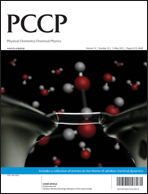From dewetting to wetting molecular layers: C60 on CaCO3(10![[1 with combining macron]](https://www.rsc.org/images/entities/char_0031_0304.gif) 4) as a case study
4) as a case study
Abstract
We report the formation of extended molecular layers of C60 molecules on a dielectric surface at room temperature. In sharp contrast to previous C60 ![[1 with combining macron]](https://www.rsc.org/images/entities/char_0031_0304.gif) 4) surface as a substrate. Non-contact
4) surface as a substrate. Non-contact ![[1 with combining macron]](https://www.rsc.org/images/entities/char_0031_0304.gif) 4) in the [01
4) in the [01![[1 with combining macron]](https://www.rsc.org/images/entities/char_0031_0304.gif) 0] direction, while a lattice mismatch along the [
0] direction, while a lattice mismatch along the [![[4 with combining macron]](https://www.rsc.org/images/entities/char_0034_0304.gif)
![[2 with combining macron]](https://www.rsc.org/images/entities/char_0032_0304.gif) 61] direction results in a large-scale moiré modulation. Overall, a (2 × 15) wetting layer is obtained. The distinct difference observed microscopically upon C60
61] direction results in a large-scale moiré modulation. Overall, a (2 × 15) wetting layer is obtained. The distinct difference observed microscopically upon C60 ![[1 with combining macron]](https://www.rsc.org/images/entities/char_0031_0304.gif) 4) compared to other dielectric surfaces is explained by a macroscopic picture based on surface energies. Our example demonstrates that this simple surface-energy based approach can provide a valuable estimate for choosing molecule–insulator systems suitable for molecular
4) compared to other dielectric surfaces is explained by a macroscopic picture based on surface energies. Our example demonstrates that this simple surface-energy based approach can provide a valuable estimate for choosing molecule–insulator systems suitable for molecular
![Graphical abstract: From dewetting to wetting molecular layers: C60 on CaCO3(10 [[1 with combining macron]] 4) as a case study](/en/Image/Get?imageInfo.ImageType=GA&imageInfo.ImageIdentifier.ManuscriptID=C2CP40172J&imageInfo.ImageIdentifier.Year=2012)

 Please wait while we load your content...
Please wait while we load your content...
![[1 with combining macron]](https://www.rsc.org/images/entities/h2_char_0031_0304.gif) 4) as a case study
4) as a case study